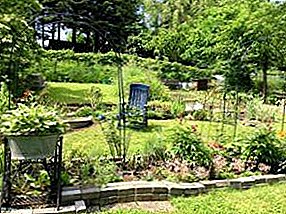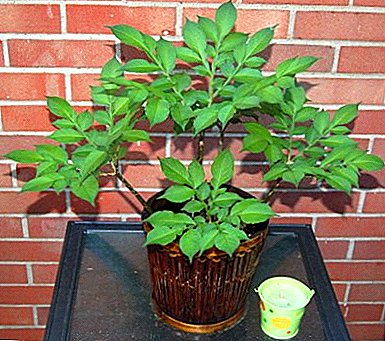
For many owners of a country house, a native abode is not just a home, but a continuation of the soul, a place for physical and emotional relaxation.
Therefore, the desire to make this place beautiful causes interest among summer residents in landscape design, the science of how to turn a garden from a series of beds and spontaneously growing trees into a work of art.
Information on landscape design on the Internet is enough, but it is easy to get confused and misunderstood.
There are mistakes in the design of the garden, which can spoil the harmony of the backyard plot, even if work and creativity are invested in it. Let us list them in order to know which techniques should be used in the planning of the garden, and what should not be done.
Error 1: There is no connection between the house and the garden
 The formation of the connection between the house and the garden is one of the well-known methods of landscape design.
The formation of the connection between the house and the garden is one of the well-known methods of landscape design.
This effect is necessary to create a single atmosphere inside the ensemble.
The atmosphere is an ephemeral concept that is the result of a successful design and is felt by the hosts and guests who appreciate the beauty of the site.
However, not everyone understands how this effect can be achieved in practice..
The very first logical solution is to connect the house and the garden with the help of plants.
For this purpose do the following:
- green veranda;
- planted flower beds in front of the porch;
- vertical plants are "letting" on the walls;
- make out the porch with huge pots of flowers.
An inexperienced gardener has the impression that a connection has arisen, but an experienced designer will immediately determine that the garden is separate and the house is separate.
The reason for this is that the mistake was made at the level of the idea: the plants do not create a connection, they only help to realize it.
How to achieve harmony at home and garden?
Repetition of motives
- Similar elements of decoration. Decorative details of the facade, such as wood carving, can be repeated on the bench.
- Same type of materials. Flowerbeds can be delineated with bricks used for walls.
- The same color scheme. The color of the roof can match the color of the track.
- Use similar shapes and lines. If the house is replete with sharp, rectangular shapes, then in the garden repeat the rectangular elements (form of a pond, a garden of stones, flower beds with flowers). If the house has circles or ovals, then these forms are used in the design of the garden.
Ways to make the transition from home to garden
Transition - this means the creation of design elements that are between the house and the garden, for example:
- terrace,
- steps,
- a gazebo with a bench
- path from the porch with small beds on the sides.
To achieve a smooth transition, planting is required.
Entrance areas
In the achievement of connectedness, a key role is played by the design of the porch, the door, as well as the wickets. To create a solid impression, the door should not look like a contrasting element.
Error 2: Invalid space zoning
 One of the rules of landscape design is zoning..
One of the rules of landscape design is zoning..
Proper division into zones allows you to draw attention to the various elements without losing their relationship.
Examples of zones:
- pond;
- table with a bench;
- flower garden;
- garden;
- fountain;
- patio.
A good design is determined by the presence of the site structure. It is not enough just to place one spectacular object; to create integrity, there must be a connection between the zones.
How to achieve this:
- The presence of boundaries in each zone. It can be small fences, partitions entwined with plants, the borders can be lined with stones, large enough areas can be seated at the edges with bushes.
- Transitions from zone to zone. The presence of tracks having intersections.
- The partitions should not be too large, high or solid, so as not to lose the feeling of connection between the zones.
Types of partitions
The partition must be airy and open, so that perception does not stick to a dead end, and attention flows from one decorative element to another.
A variety of partitions:
- mesh partitions;
- arches and arched tunnels;
- small picket fences;
- line of multi-colored pipes;
- rope net;
- modern forged structures;
- palisades.
Openwork partitions - a great opportunity to use the plants for decoration, ivy, you can design a metal structure and a paling, at the foot of the arch to plant bush flowers.
All these secrets allow you to divide the garden into zones and at the same time create visual transitions between them.
Error 3: Attempting to create a garden structure using vertical gardening
 Some gardeners overload the garden with vertically growing plants, in the hope that this will give the garden an elegant structure.
Some gardeners overload the garden with vertically growing plants, in the hope that this will give the garden an elegant structure.
Such a move leads to the fact that the greenery looks like a separate array.
To create a structure in landscape design is carried out reception "vertical garden".
It can be achieved only by creating several levels of the garden and by introducing vertical elements, such elements can be decorated with plants.
Ways to create multi-level:
- steps;
- flowers planted in size;
- the presence of several objects, different in height, near;
- creating artificial levels. This is done through the importation of soil, for example, you can make a bed a level higher;
- bridges, which can be both over reservoirs, and over decorative streams of pebbles or flowers;
- alpine slides;
- a gazebo on a stepped foundation on which pots of flowers are placed.
Error 4: The fence is practical, but not aesthetic
The fence is the first thing that a guest sees when approaching a house; this is a rather extensive design element that is always striking. The purpose of the fence is safety and comfort. The fence can be a decorative element, while maintaining its practical use.
How to achieve harmony of the fence and the garden, so that it does not stand out from the overall composition?
If the owner is at the stage of choosing a fence, then for an interesting design you can choose:
- multilevel picket fence;
- inserts in the form of geometric shapes;
- round arch over the gate.
Even if the fence itself is simple and functional, it can be decorated:
- Make an insert of colored glass.
- To cut the levels of the fence under the desired terrain.
- Install a forged fence along the fence line and plant a wild plant along it.
- Create geometric shapes inside and veneer them with stone.












